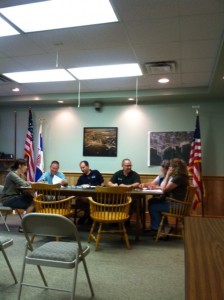Mattapoisett’s Planning Board had only one item on its agenda: a meeting with Sandy Conaty, Comprehensive Planning Manager from SRPEDD. But this meeting is perhaps the beginning of massive zoning changes that will shape the complexion of Mattapoisett for decades to come.
The Board had submitted their comprehensive master plan to SRPEDD to get “the ball rolling, to get the road map started,” Chair Tom Tucker said.
Mattapoisett had applied for and received grant money to work with SRPEDD, to get expert assistance as the Planning Board and other entities move forward in shaping the future of land use.
Noting that the present zoning bylaws are a patchwork quilt that has been added to over time, inhibiting the public’s ability to easily and clearly understand the objective of any bylaw. Board member Ron Merlo said, “I have a concern that through the ages things have been put on and put on and put on … things need to be cleaned up. I’d like to see some administrative assistance to make things easier to use.”
He added that oftentimes residents and others have to go back and forth between various boards charged with handling zoning issues, and he felt the town could do a much better job for the public and the necessary improvements the town needs in the future.
Conaty said she had started going through the housing bylaws, the five-year update of priority protection areas, but had not yet tackled review of the master plan. She was aware of the effort the town has put into trying to secure public opinion on the future of open space and recreational areas. She will be looking at bylaws that will help the town address diverse land use needs.
Several members said that the lack of zoning bylaws for utilities like solar and wind need to be addressed so that they wouldn’t be blindsided, as they were when a telecommunication tower slid past their purview.
Conaty asked if the board members had studied zoning bylaws from other towns to acquaint themselves with what is working well in those locations. None had to date, but thought that might be a good starting point. Dartmouth, Conaty said, used a good model for zoning with the establishment of sectors. She said that each zoning sector simply had to look at the packet for that specific type of permitting to know what the town would require, rather than skipping from one board to another asking if their involvement was needed in the process.
“If your property is in the business district, that’s all you need to look at,” Conaty said.
Board member Karen Field said, “I think people move to Mattapoisett for its quaintness, its schools; it’s a special space,” intimating that Dartmouth’s land use might not work well for Mattapoisett. Conaty assured her that she was not recommending their bylaws or zoning districts but their format, which may be useful.
“I’ve been wondering about signage,” Member Mary Crain said. It was pointed out that depending on where the sign is proposed to be placed, or the type of use of the location, dictated the type of sign that would be allowed. However, one has to skip around the bylaws to ascertain what the requirements are. This was one example of the present state convoluted condition of the zoning bylaws.
Merlo commented, “Things like that are missing, and it’s a great opportunity to incorporate things.”
Conaty said another item that might be beneficial was a table for parking requirements. She pointed to Seekonk as a town that had done a good job in making parking requirements clear.
Tucker suggested that the public be made aware of the process and the assistance that SRPEDD will be providing through this grant. Member John Mathieu said that one bylaw at a time should be tackled in upcoming meetings, rather than trying to attack everything all at once. Tucker said he wanted to give the public ample opportunity to understand the work at hand, the importance of their input, in the hope that by doing so, residents won’t feel left out of the process and would actually come forward and participate.
Conaty said it’s vitally important that the public understand SRPEDD is not writing bylaws but instead assisting in format changes that will make the bylaws easier to understand and work with. She said she would submit a process flowchart with deliverables and goals so that everyone could work toward better bylaws.
Time once again became the enemy, as the board looked at how to pack in public hearings by December. The deadline for using the grant money and completing the work is Dec. 31.
The public will be invited to participate in a “Framework Meeting” on Sept. 16 to kick off the review of the town’s zoning bylaws. The first meeting will give the Board the opportunity to show the public an overview of the entire process and what zoning bylaws will be addressed at each subsequent meeting until all had been reviewed and rewritten in the updated format. In this way, people with only interest or special interest in specific bylaws need not necessarily attend all the public meetings; just those they were most interested in.
“SRPEDD will make recommendations … on what the Planning Board can do to improve the layout of the bylaw, with better continuity of the bylaw,” Conaty said. “Overall, to make it more understandable.”
The Planning Board discussed ways to engage the public, noting that the poor showing thus far to an invitation to take the land use survey on line was dismal at best. To date, only 60 residents have completed the survey. Public hearing notices will be sent to local newspapers and possibly fliers left in public locations. Engaging the public to solicit their opinion on the future of Mattapoisett’s land use continues to be an ongoing struggle, but has been deemed necessary for the future health of the community.
By Marilou Newell
